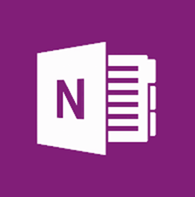I'll be the first to admit that I never used any Microsoft product except the Office Suite until this year. A colleague introduced me to OneNote (a Microsoft product) last year, and I didn't see the value. I already had an Evernote account, so why switch to OneNote?
Earlier this year, though, I went to TCEA with several teachers from my building. One of them is a Microsoft advocate (hi, Scott!) and kept raving about OneNote, so I finally decided to see what all the fuss was about.
I can now say that I've transferred all my Evernote contents to OneNote, and I don't even use Evernote anymore! For me, OneNote is the way to go for organizing files in my personal and professional life.

In a Nutshell
The concept of OneNote is simple: create virtual binders in which you can add virtual dividers and pages for optimal organization.
Features
- Create as many binders as you want with as many tabs and pages as you want
- Color-code tabs and pages
- Use any font on your system (I'm a font snob, so that capability is import to me! Kidding...kind of)
- Add tags to notes for further organization
- Create to-do lists that you can actually check off
- Import or create tables, graphs, charts, pictures, links, screenshots, or spreadsheets so they are visible without having to click and open documents
- Upload any of the above-mentioned items -- this shows an icon with the item for you to click and open
- Record audio and video directly within the binder
- Use free page templates to easily format your pages to look however you'd wish
- Draw on a page in any color (highlight, too!)
- Insert shapes
- Export pages in a variety of formats
- Password protect sections of any binder
- Put a binder within a binder
- Share binders with others -- they can have viewing or editing rights
- See recent edits in the binder and who made them
How I Use OneNote Professionally
I have four tabs -- called "sections" in OneNote -- they're the blue, orange, pink, and purple colors you see in the picture above. Each has several pages inside. So, for instance, the "materials" tab has 26 pages -- one for each letter of the alphabet -- where I keep track of materials I have in the Science Lab and which cabinet they're in.
After that, I have a separate section group for each of the grade levels I teach + one for PO information. When I click on a section group, it opens to what basically looks like a binder within a binder. So, for instance, this is what my 1st grade binder looks like:
In this way, I think OneNote is even more versatile than a real binder because I can't keep physical binders within physical binders. :) And obviously, you can't really put attachments into physical binders, either.
In my grade level binders, each section contains every lesson I teach in that unit. I also have a page at the top of each section for the materials I need for that unit -- all consumables are written in green so I can make my Walmart list quickly, and any printable materials are written in red.
I also have another binder that's for teaching but doesn't have anything to do with my lesson plans:
Instead of a notepad that I'll promptly lose, I take my iPad to meetings and use the free app to take notes in the "meetings" section of this binder. You'll also notice the "PD" tab, where I take notes at any professional development workshops or conferences I attend.
I love the seemingly endless amount of capabilities OneNote has and how users can customize it to fit their life and needs!
Other Ideas
Instead of a notepad that I'll promptly lose, I take my iPad to meetings and use the free app to take notes in the "meetings" section of this binder. You'll also notice the "PD" tab, where I take notes at any professional development workshops or conferences I attend.
I love the seemingly endless amount of capabilities OneNote has and how users can customize it to fit their life and needs!
Other Ideas
- Student conferencing tool - Create a tab for each student. When you meet with students about, say, their reading, create a new page to document the meeting. Record a student reading and store in his/her OneNote tab so you can more easily track his/her progress.
- Professional development - Organize meeting, conference, or workshop notes
- Resources - Do you have a lot of random sheets of paper you have to file away for your class? Attach them all in OneNote so they're easy to preview, find, and store.
- Parent contact log - Use the table option to create a log for parent contacts. You can record text or audio notes about who was contacted, what the meeting was about, the method of contact, etc.
- Student examples - scan and attach student examples for big projects so you'll have something to show future students.


I have just recently started using OneNote too and love the freedom of typing anywhere on the screen and the ease of inserting pictures. I didn't know I could have section groups or password protect tabs. Thanks for the tips!
ReplyDelete